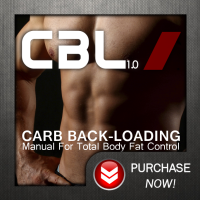In anticipation of the upcoming release of the next Shockwave Protocols programming system, here’s a newly edited re-release of the original introductory Shockwave article (Shockwave 1.0) from two years ago. We’re a few versions in at this point, with the biggest one to come, but this blast from the past should give you a general idea of what the program is all about. Enjoy.
I wish this program had a sexy story, that it was born of some black-ops bodybuilding program, utilized long-forgotten methods of motor-unit control from ancient Hindu yogini, or was stumbled upon during epigenetic manipulation of the world’s most powerful athletes.
It wasn’t. The truth is far simpler, and it’ll sound familiar: I wanted a way to get as lean as possible without sacrificing muscle or strength—a lofty goal, one chased for decades with little success.
Most big name trainers simply have their clients do more reps and more sets, with less weight, upping the cardio and cutting the calories. Getting lean is the only goal, and muscle loss is an acceptable part of the program. When it’s over, their clients look like sucked-out zombies. Their muscles are striated and vascular, but flat and emaciated. If they’re lucky, their trainer knows enough to help them load carbs properly and they’ll look okay—but nowhere even close to stellar.
If I put in 20-25 hours of training per week-a standard prescription during a cutting phase—to lose muscle and look like this guy, I’d be pissed.
If you’ve done your homework, you shouldn’t be surprised by massive muscle loss. Every part of this prescription amplifies catabolic signals and shuts down anabolic ones, from genetic regulators to hormonal cascades. These top physique trainers—I won’t name names, because we all know who they are—consistently sabotage their clients’ physiques and decimate the results of their years of training.
I lived under this shadow for years. Every time I wanted to lean down, I upped the resistance training volume and blasted my body with cardio. This never worked the way I wanted it to. What I wanted was maximum anabolic signaling (I wanted my body to do everything possible to grow) and minimum catabolic signaling, meaning I wanted my body to forget about ever using my muscles as a source of protein. What I wanted for dieting was exactly what I wanted for hypertrophy. The training should be no different.
I realized this about four years ago, and there’s really no excuse for it. I should have thought of it a decade ago. The details of my search would bore even the most interested readers, so I won’t go through all of that here. Suffice it to say that I tried everything: Heavy Duty, Poliquin Principles, and even variations of 5/3/1. These worked great for their respective goals when I had adequate calorie intake, but as soon as I began dieting, or even limited carbs in my diet, everything went to hell.
This taught me two things:
1. Carbs are a powerful anabolic potentiator.
2. None of these programs both maximize anabolic signals and minimize catabolic signals. If they did, I wouldn’t lose strength and mass as soon as my nutritional balance went negative.
What the hell is going on here? These programs are time-tested and practically Mother Nature-approved, right? My frustration made me do something even more stupid: I tried a super-high volume bodybuilding routine, thinking volume would lead to hypertrophy when coupled with a diet designed for growth. Try to trim down while using one of these super-high volume routines, however, and you’ll have a disaster on your hands.
Finally, I tried the internet.
After sifting through countless web articles looking for new ideas and new veins of research, I bought Christian Thibaudeau’s book High Threshold Muscle Building. I don’t always agree with Thib, but I have nothing but respect for the guy. He has experience with athletes of all levels, and he does his research. His book didn’t disappoint me, and it got me back on track to achieve my goal. If you want to see the inspiration for much of this, search the web for “The Perfect Rep,” an article Thib wrote a few years back.
Eccentric Loading-Explosive ConTraction (ELECT)
For those of you who haven’t read Thib’s piece, here’s a synopsis:
In a nutshell, Thib’s perfect rep explodes the weight through the contractile-lifting phase to prime the nervous system for maximal lifting. This is more properly described as the Eccentric Loading-Explosive ConTraction (ELECT) method. At the top of the movement, the idea is to perform the turnaround quickly, lowering the weight quickly. The transition through the bottom of the movement is called the stretch-shorten cycle (SSC) in scientific literature. This is the turnaround point from the eccentric to concentric phase of a rep—from lowering the weight to raising it. The SSC should be as short as possible. Thib refers to the midpoint of the SSC as the stretch-relaxed position (SRP), so don’t get confused here.
Thib and I differ in our recommendation for the duration of the eccentric phase. The lowering phase for upper body movements should be performed in roughly one second. For lower body movements, this should take three seconds, and it should never be dropped. This may seem odd, but as of this moment, from studies focusing on upper body movements, a one second eccentric phase appears to elicit maximum growth, while a three second eccentric phase appears to cause maximum hypertrophy in leg muscles. Why the difference? We’re not sure, but that’s what the research tells us.
To get a little more kick out of the turnaround, Thib suggests dropping the weight through the last quarter of your range of motion before switching directions. Realize that your muscles need to bear the full load of this turnaround. When you’re bench pressing, for example, dropping the bar like this then letting it hit your chest and bounce back up misses the point—and the benefit—of this method of rep performance. You need to stop the weight and turn it around before it reaches your chest.
Say Goodbye to Sets
When implementing ELECT, the idea of a set becomes a little confusing. Each “set” is actually only 2-4 ELECT reps, followed immediately by another set of 2-4 ELECT reps at a higher rate—and so on for an attempted five sets. With the aid of a spotter, on a selector-type machine, or if you bust your ass, each group of ELECT reps becomes part of one long set of 10-20 reps.
Loading of weight for the one set per movement—or set of mini-sets—works like this:
Perform three ELECT reps of the exercise at a low starting weight (from 35-50% of your one-rep max). The turnaround should be made in the absolute shortest time possible without a bounce and without using your body’s momentum. These reps should feel easy. When you’re done, increase the weight as quickly as possible and perform three more reps in the same fashion. You should be moving fast enough for this to feel like one long set of 15 reps. The amount of weight you do depends on the exercise—and the entire program (with detailed specifics) will be available with the re-release.
As an example, my current bench press numbers are as follows:
|
Set |
Weight |
% 1RM |
|
1 |
135 lbs (≈ 60 kg) |
33% |
|
2 |
185 lbs (≈ 84 kg) |
45% |
|
3 |
225 lbs (≈ 100 kg) |
55% |
|
4 |
275 lbs (125 kg) |
68% |
|
5 |
315 lbs (≈ 143 kg) |
78% |
If any rep on any mini-set turns into a grinder, or you hit failure (even if it’s the first rep of the second ELECT sequence), you’re done with that movement. You either tried to use too much weight or your nervous system is shot. By quitting at this point, you’re ensuring that you’ve fully activated the muscle for growth, and that you’re preventing CNS burnout. It’s a built-in regulator to prevent overtraining.
Intra-rep changes in resistance, like using chains or bands with bench pressing or squatting, can increase the effectiveness of a movement. If you have these implements and know how to use them, feel free. If you don’t, don’t worry about it. Even without accommodating resistances, this program will produce exceptional results.
Using this method for prescribed sets and reps, these workouts are fast, exhausting, and naturally incorporate high-intensity interval training (HIIT) into your resistance routine without having to perform extra cardio. For extreme leanness—women trying to hit 10 percent or lower body fat, and men shooting for six percent or lower—more HIIT will be necessary, but surprisingly little. Trainees who use this method can’t believe how much they sweat for such a small amount of training volume.
Periodization Value
The best strategy that can possibly be employed is the idea of periodizing your training from day to day. This is called daily undulating periodization (DUP). Unfortunately, because powerlifting training is so taxing, DUP isn’t feasible—it’s extremely difficult, in any event—to incorporate. Because of the efficiency of this program, however, DUP integrates nicely without risking CNS burnout or overtaxing your energy reserves.
Apart from supplementing with DUP for strength enhancement, the overall progression model is the tried and tested linear progression—with no other type of periodization involved. When you feel stronger, you go up in weight. Simply put, Shockwave gives you precisely what you need, every single day—no more, no less.
A Few More Considerations
There’s also a final, optional component to this program. I use this for my squat, deadlift, and bench. Whenever I feel I have reserves during a workout that includes one of these lifts—or on a day when I train these muscle groups—I perform one or two reps of a pause-press set. For example, if after my first movement on chest day I feel particularly strong, I’ll do one set of 1-2 reps with 365 pounds (approximately 166 kilograms) in pause-press fashion, i.e., I’ll lower the weight to my chest, hold it for a two-count, then press it back up with everything I have. This amplifies power production.
I’ll explain how and where to fit this type of training in with the re-release—which we’ll be announcing and launching soon.
What’s in a Name?
Training protocols are getting tough to name, and I thought long and hard before settling on Shockwave. This is a perfect name, because there’s more than one type of shock wave. Some are easier to achieve than others, and creating one varies from day to day with several factors.
What I’m introducing here is the same thing. There’s more than one type of Shockwave Protocol. There’s a Shockwave designed specifically for lean muscular gains. There’s one for getting ripped. And there are Shockwaves that are just for women. Some are harder to work with than others because they require more planning. Others give you more flexibility.
Shockwaves incorporate diet, training, gender, and physiological status so you can optimize your day-to-day achievements. If your goal is fat loss, you can ensure that every day is a step toward that goal. If it’s hypertrophy, the mirror will show you very fast changes, because your body progresses constantly—instead of tricking your mind into thinking your body is progressing simply because you’ve made it through three steps of a seven-step program. If the only way people can see that you’ve progressed is on a piece of paper, you’re using the wrong program.
The Shockwave Protocols are designed for variable daily intensity, a method you can employ to advance your training beyond what you’ve thought possible. The extent and intensity of your workouts will vary from day to day. You may have an intense training streak for weeks before your first bad day happens. This is where Shockwave allows you to adjust by performing only certain levels of work. Take it easy on these bad days—just do the prescribed levels and go home.
Training factors change daily. This includes your nutritional balance, stress, hormonal status, and CNS efficiency. Most training routines base progression and protocol on the assumption that all these factors are optimized every single day, but that’s not going to happen. With Shockwave, you tailor the training session to the status of your body, instead of trying to tweak a hundred different parameters of your day so your body is ready for a workout. Shockwave matches your training intensity to the reality of an imperfect world.
It’s also very easy to use. What you’ll see on your training schedule are different levels for each workout. Judge where to stop based on how your body feels that day. Most of the time, you’ll pass through all the main levels. On days where you feel particularly strong, you’ll perform an extra level. On days that aren’t so good, you’ll cut out a level or two. When you feel like total shit, maybe you’ll skip the workout entirely—or stop after the warm-up level.
The levels are structured as follows:
Level 0 : Warm Up
Level 1: ELECT Movements (work several muscle groups)
Level 2: Auxiliary Movements (work specific muscle groups)
Level U: DUP Movement (works a conjugate body part)
Level X: Pause-Press Movement (blow it out!)
The Future of Shockwave
I have to apologize at this point, because this article is just a preview of what’s coming. We’re not finished redesigning the new version of The Shockwave Protocols for public release yet. It’s definitely going to be worth the wait, though—with new material, a video component, and full explanations of everything in the program, including information on precisely how to integrate Shockwave with Carb Back-Loading and The Carb Nite Solution. Stay tuned.











Recent Comments